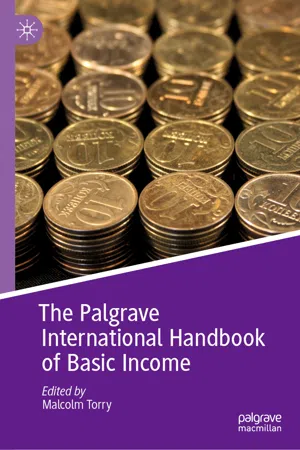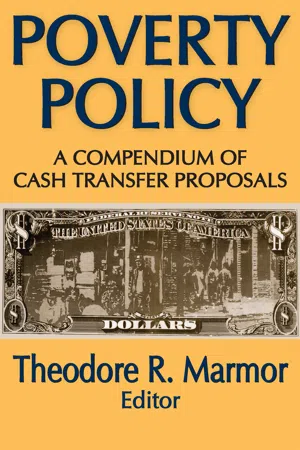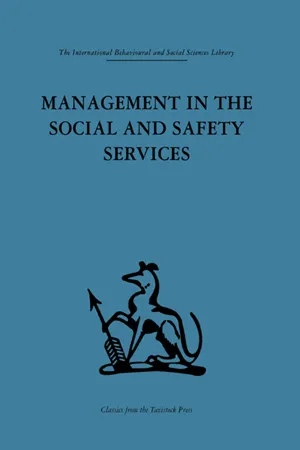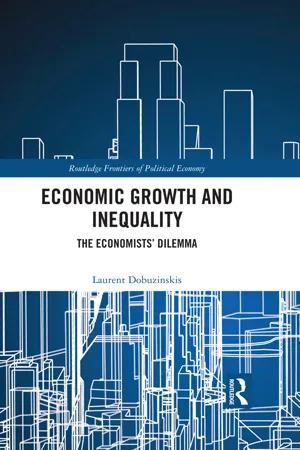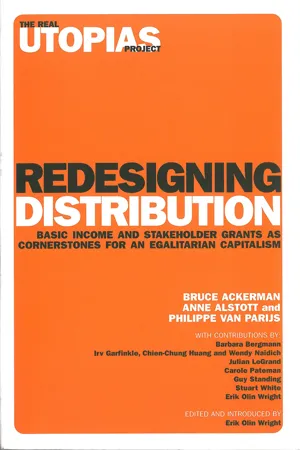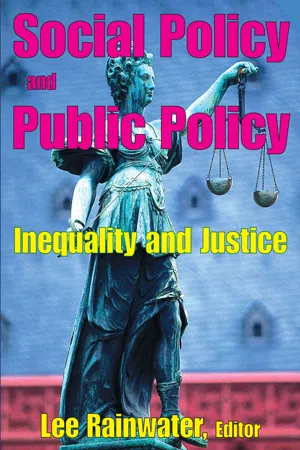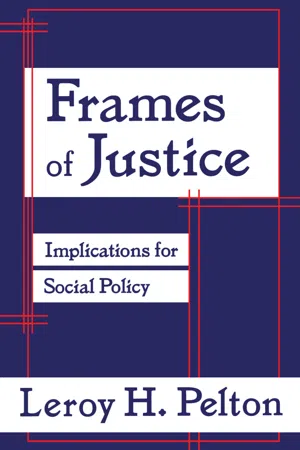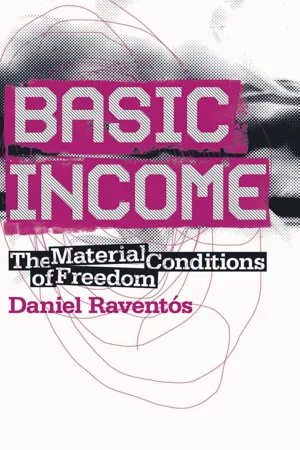Economics
Negative Income Tax
Negative income tax is a government policy that provides income support to low-income individuals by supplementing their earnings. If a person's income falls below a certain threshold, they receive payments from the government instead of paying taxes. This system aims to reduce poverty and inequality by ensuring that everyone has a minimum level of income.
Written by Perlego with AI-assistance
Related key terms
Related key terms
1 of 4
Related key terms
1 of 3
10 Key excerpts on "Negative Income Tax"
- Malcolm Torry, Malcolm Torry, Malcolm Torry(Authors)
- 2019(Publication Date)
- Palgrave Macmillan(Publisher)
income earners the only labour market finding was a small increase (a matter of two weeks or so per year) in time spent between jobs. This is hard to interpret across a great distance of time, but it is plausible that more efficient matching of employer to employee would be one effect of such an increase. Certainly there was no evidence of main earners withdrawing from the labour market altogether.If implemented, a Negative Income Tax would- be paid to individual s, not households;
- be set at a level which provides a basic floor standard of living ;
- be withdrawn at a rate which provides clear work incentive s;
- not be work-test ed, and so would be experienced as very different from many countries’ current means-tested benefits .
A Negative Income Tax of this nature would be similar to a Basic Income in many respects, and it would offer many of the same advantages, and particularly lower marginal deduction rates and therefore better employment incentives . The difference is that a Basic Income would be paid at the same rate to everyone of the same age, and incomes would then be taxed in order to pay for it, whereas a Negative Income Tax would only be paid to individuals whose earnings fell below an earnings threshold, and would be paid in proportion to the amount that earnings fell below that threshold. Figures 12.1 and 12.2 show both the differences between the payment mechanisms, and the identical relationships between gross and net incomes.Fig. 12.1The relationship between net and earned incomes when a Negative Income Tax is implemented(Note The line EF shows net income. At the threshold £y, neither a Negative Income Tax is paid out nor Income Tax collected. As income falls below the threshold, a Negative Income Tax is paid. As income rises above the threshold, Income Tax is collected. [The diagram assumes that a single tax rate is charged on all earnings, and that the rate at which Negative Income Tax is paid equals the rate at which tax is collected.] Source Torry, M. [2018]. Alternatives to Citizen’s Basic Income. Citizen’s Income Newsletter , issue 1 for 2018: 6–7. The Citizen’s Basic Income Trust’s permission to reproduce the diagram is gratefully acknowledged)Fig. 12.2 The relationship between net and earned incomes when a Basic Income is implemented(Note A Citizen’s Basic Income of £x per week is paid to everyone. All earnings are taxed. The line EF shows the net income. [The diagram assumes that a single tax rate is charged on all earnings.] Source Torry, M. [2018]. Alternatives to Citizen’s Basic Income. Citizen’s Income Newsletter- eBook - ePub
Poverty Policy
A Compendium of Cash Transfer Proposals
- Theodore R. Marmor(Author)
- 2017(Publication Date)
- Routledge(Publisher)
In addition, there is growing support among welfare administrators to grant eligibility to applicants on the basis of a simple affidavit, which is not very different from the simple income tax forms used by low-income taxpayers. As this practice spreads, claims of welfare recipients will be checked more and more on a sample basis, a practice which has been employed by the Internal Revenue Service from the beginning of the income tax. In fact, a public assistance system or Negative Income Tax requires decisions on the definition of income and of the family unit, the tax rate (or rates), methods of payment, and a reporting system—all of which have been settled in one way or another in the positive income tax. There is no reason why we should not learn from this experience to improve the administration of the welfare system and to protect the dignity of those who are receiving assistance.But when one begins to think seriously about a Negative Income Tax, many of the inadequacies of the positive income tax become apparent. A less than comprehensive definition of income is apparently tolerable under the positive income tax, but it is surely not tolerable under a Negative Income Tax. For example, I doubt that anybody would agree that a recipient of $10,000 of tax-exempt interest annually should be eligible for a Negative Income Tax payment. Similarly, the unit under the positive income tax is the individual; the appropriate unit for the Negative Income Tax is the family, since the family provides the basic economic support of its members. Finally, Negative Income Tax allowances should be based on the relative budgetary needs of families of different sizes, but these are not even roughly approximated by the exemption structure of the positive income tax.Such considerations are important not only for the Negative Income Tax, but also for their possible impact on the positive income tax. To mention only one example, it will doubtless be difficult to explain why some people might be required to pay positive income taxes even though they are eligible for Negative Income Tax allowances, and this will inevitably raise questions about the adequacy of the personal exemption and the minimum standard deduction.Tax experts showed little interest in the welfare system until very recently. But this situation has been changing rapidly. Numerous articles on public assistance and Negative Income Taxation have appeared in the newspapers as well as in the technical journals, and the topic is actively discussed in government circles. This attention by experts has already raised the level of public discussion of these issues. Although it is impossible to predict the ultimate outcome, it is clear that Negative Income Taxation and its relation to the positive income tax will be lively issues in the 1970s. - eBook - ePub
- Joseph A. Pechman(Author)
- 2019(Publication Date)
- Routledge(Publisher)
Whether assistance in kind should be abolished once cash assistance is increased in amount and in coverage is more doubtful. In general, we suggest that if public housing, the food stamp programme and medical programmes for the poor are to be continued, they should be justified, and modified, by considerations other than income maintenance. For example, under an adequate Negative Income Tax the means test presently used in the determination of eligibility for public housing could be eliminated, and rent subsidies eventually could be eliminated. Eligibility for housing built under government programmes would not depend on income levels. Public funds might still be made available by the government at rates below the market rate of interest, but these loans would be related to urban renewal programmes and to the elimination of discrimination in the housing market—and not to considerations of income maintenance. On the other hand, society will not allow anyone to be without essential medical care, even if his inability to pay for it reflects improvidence rather than poverty. Therefore, it is unlikely that direct assistance in kind in the health field can be eliminated until a comprehensive, compulsory health insurance plan is adopted.Integration with Social Security
The Negative Income Tax might be integrated with social security in two ways. One approach would be to cover people by both social security and NIT allowances. In this case, as explained above, social security benefits would be counted partially or fully as income subject to offsetting tax.Alternatively, if minimum social security benefits were set at levels adequate for all groups, it would be unnecessary to include the aged and the disabled covered by OASDI in the Negative Income Tax plan. Those who are not now eligible under the social security system could be blanketed in, and the cost of their benefits reimbursed to the social security trust fund from the general treasury. This cost would be relatively small since the vast majority of retired people are already covered by social security.Nevertheless, to raise the benefits of social security to levels high enough to make the Negative Income Tax unnecessary for retired people would probably be too expensive to be feasible. The present minimum social security benefits of $792 a year for a retired worker and his wife would have to be raised substantially, and it is unlikely that this could be done without increasing OASDI benefits across the board. This would be an expensive and inefficient way to meet the objectives of income assistance, because large amounts of additional social security benefits would be paid to people whose incomes are adequate. - eBook - ePub
- Norman C. Hunt, W. D. Reekie(Authors)
- 2013(Publication Date)
- Routledge(Publisher)
Taxes as a proportion of national income have increased from 24 per cent in 1933 to 43 per cent in 1970. Consequently, instead of income tax being largely paid by the minority in higher income groups while the majority receive social security benefits, the two groups now largely coincide. 5 Thus greater equality of incomes and tax obligations has created the situation of a two-way process of levying tax from and giving benefits to the same people or the same income groups, with its adverse effect on administrative efficiency and on efficiency in concentrating help on people in most need. Granted then that we are in this situation, how does reverse income tax help? The basic principle of such a system is that the state makes automatic payments to families with incomes below a specified level, on the analogy of ordinary (positive) income tax whereby payments are automatically levied as income rises above a specified level. In effect, it is a scheme for extending the income tax system to incomes below the level where income tax is now levied, and in this low income range giving instead of taking money – hence the term ‘reverse’ or Negative Income Tax. Such a system will alleviate the defects of the present tax and social welfare distribution system in two respects. First, it reduces administrative inefficiency due to the two-way process of paying out benefits to and levying taxes from the same people. Since existing social welfare benefits are merged into the automatic payment (or credit) for which people become eligible below a specified income, this two-way process is eliminated - eBook - ePub
Economic Growth and Inequality
The Economists' Dilemma
- Laurent Dobuzinskis(Author)
- 2023(Publication Date)
- Routledge(Publisher)
But from a normative standpoint, it could be argued that this particular behavior is not detrimental to the well-being of the recipients of social assistance: it provides them with the means to find a better-paying and/or more satisfying job. 27 As mentioned, a full implementation of the NIT has never been attempted. 28 From a political standpoint, the NIT is ambiguous. On the one hand, it can be presented as a scheme for helping the working poor, which is usually a popular idea. However, if those with no employment income at all would receive the maximum benefit under this plan, many voters will probably object. There is a prejudice against providing social assistance without requiring some sort of reciprocal contribution, for example, in terms of finding employment. This tends to discourage policy entrepreneurs and elected officials from aggressively advocating the NIT. A few significant steps in the direction of a NIT have nevertheless been put into effect, all in the name of helping the working poor. One such example is the EITC in the US, or the Working Income Tax Benefit (WITB) in Canada. Although childless workers older than twenty-five and earning less than a very low annual income (around $14,500 in 2015) qualify for a small tax credit, the EITC is designed to help low-income families with children. The actual mechanism is more complicated than the way in which the NIT theoretically works (as described above), but the principle is the same: below a certain income level, households get a refundable tax credit; “refundable” here means that the credit is payable in full, even if applying only a fraction of it to the amount of taxes owed suffices to bring the tax to zero - eBook - ePub
The Real Utopias Project
Basic Income and Stakeholder Grants as Cornerstones for an Egalitarian Capitalism
- Anne Alstott, Bruce Ackerman, Philippe Van Parijs(Authors)
- 2020(Publication Date)
- Verso(Publisher)
Figure 1.3 ) would be very expensive in this sense. But that the problem should be entirely shared with negative income schemes does not make it less of a problem, which needs to be faced squarely. The basic fact is that the more material incentives one wishes to provide (for a given minimum income) to people earning at the bottom of the earnings scale, the more one needs to decrease the material incentives higher up. There is a sharp trade-off here, which can be spelled out as follows.Figure 1.5. Non-linear Negative Income Tax (e.g. Mitschke 1985, Godino 1999).In order to abolish the unemployment trap without dropping the minimum income level nor raising too much the marginal rate of tax on the earnings of the bulk of the work force, various non-linear Negative Income Tax proposals have been made. The rate of benefit withdrawal is then higher than the rate of positive tax, and the Negative Income Tax scheme as a whole can be called regressive, in the sense that the effective marginal rate of tax is higher for the poor than for the rich. Such a scheme is of course nonetheless less regressive and more redistributive than conventional guaranteed minimum schemes of the type depicted in Figure 1.1 .Figure 1.6. Basic income with low earners’ overcharge (e.g. Meade 1989).Just as some Negative Income Tax proponents have proposed negative tax rates higher than positive tax rates (see Figure 1.5 ), some basic income advocates have recommended regressive taxation, for example in the form a “low earners’ overcharge” on top of the standard rate of tax, as the best way of sustainably funding a relatively high basic income. The unemployment trap is abolished less vigorously than in the linear case, but the material incentives for skilled workers to supply labor, make efforts and improve their skills are eroded to a lesser extent. Even with this “tax on the poor,” this sort of scheme is of course again less regressive and more redistributive towards the poor, than existing guaranteed income systems with the same level of minimum income (as in Figure 1.1 - eBook - ePub
Social Policy and Public Policy
Inequality and Justice
- Lee Rainwater(Author)
- 2017(Publication Date)
- Routledge(Publisher)
The present system of public assistance has failed. Inadequate in coverage and in benefits, perverse in its incentives, it fosters the very conditions it is supposed to relieve.We urgently need a reformed and nationalized system of income assistance that does not exclude employable men and their families. In my opinion, this should be meshed with the federal income tax. The credit income tax seems the fairest and simplest solution. But it will take a long time to develop political consensus for so drastic a reform, and meanwhile something must be done. The merit of the Negative Income Tax approach is that a workable and equitable system of aiding the poor can be introduced within the framework of present federal income taxation.Which NIT proposal should it be?. . , Meanwhile, I would venture the opinion that the tax rate should not exceed 50 percent. I also find it hard to justify guarantee levels significantly below poverty lines except as a temporary and transitional feature of a new system.Together these specifications imply a system like the one illustrated in Table 10.5 , column 2, and in Table 10.6 . This is a costly proposal, and if the budgetary resources could not be found at once, it could be gradually introduced as follows: Keep the suggested break-even incomes, which for most family sizes are roughly twice the poverty thresholds. Start by making up, say, only one-quarter of the amount by which a household’s income falls short of this break-even level, and step up the rate gradually until it reaches 50 percent. During the transition the existing public assistance system would be gradually phased out. But states and localities that wished to augment the benefits available to the poor under the federal NIT system would be able to do so, perhaps even with some federal financial help.The main obstacles to reform are ideological and fiscal. The widespread, if largely groundless, fear of freeloading can be met by making part, not all, of the assistance to families conditional on the willingness of employable members to present themselves for work or training, and by providing assistance in a way that rewards self-reliance. The budgetry cost is formidable, especially if we impose on ourselves the rule that taxes can never be increased. But the war on poverty is too crucial to be relegated to the status of a residual claimant for funds that peace in Asia and the normal growth of tax revenues may painlessly and gradually make available. - eBook - ePub
Frames of Justice
Implications for Social Policy
- Leroy H. Pelton(Author)
- 2018(Publication Date)
- Routledge(Publisher)
Alternatively, we can say that income under a certain amount not only should not be taxed, but should be supplemented by government support up to that amount. This can be counted as one variant of what has been called a Negative Income Tax structure (Friedman, 1962, pp. 191-195; Atkinson, 1975, pp. 227233). Further, we can decide that this amount be set at a level sufficient to address minimal human need. The only problem here is that if we set the minimal amount at, say, $10,000, then a person who chooses not to work will have the same income as one who holds a job paying $10,000 per year, and we do not consider this to be fair. In fact, in that the government transfers $10,000 to the former and nothing to the latter, this arrangement can be considered discriminatory against working people.Thus we would need two minimal levels, one which no one is allowed to fall below for whatever reason, say, $10,000, and one, say $20,000, at which and below no taxes are taken. In between no income and an income of $20,000, the minimal income support would be reduced by $500 for every $1,000 of income, and so would be reduced to zero at $20,000. This would constitute another variant of a Negative Income Tax structure. Since the income support is usually designed to diminish to zero at fairly low levels of income, the rate at which the income support is reduced (here, 50 percent) is often set considerably higher than the positive income tax rate for the next income bracket starting at $20,000. The problems here are that we are back to a tax structure with multiple tax brackets—one, in fact, in which the tax structure is regressive in that the “tax” on income below $20,000 is, in effect, higher than the tax on income above $20,000—and that tax policy is, in effect, deliberately being used to provide “incentives” for work rather than solely for filling the treasury in a fair manner.A Universal Social Dividend and Taxation System
To summarize, beyond the proposition that the community exists to benefit the individuals within it, I began with the moral value of the sanctity of human life and the fundamental principle of nondiscrimination, and construed these to comprise the moral foundation of liberalism. From this foundation, I drew the implication that a liberal and just community, through its instrument of government, is obliged not to allow basic human needs to go unaddressed, and must address such need without judgment or discrimination. Further, I concluded that the common practice of utilizing the concept of desert as a dimension of social policy is highly problematic in that, at the very least, it constantly challenges the principle of nondiscrimination, and therefore justice, with debatable claims and distinctions. I also suggested that the community, being more than and different than the sum of the individuals within it and their individual efforts, has qualities of its own that do not reside in individuals, such as a democratic form of government, or environmental regulations, that in synergistic combination may produce wealth above and beyond individuals’ efforts, and which, in a sense is not “earned” by most, if any, individuals within that community. It can be considered a communal wealth, in that it is in excess of that which would have accrued to individuals, despite their efforts, in absence of community. The existence of this excess wealth is certain, even though we have no means of measuring its precise quantity. - Robert A. Moffitt, Robert A. Moffitt(Authors)
- 2016(Publication Date)
- University of Chicago Press(Publisher)
One resolution to this problem might have been to try to improve program “tagging,” while accepting that no tagging system would be perfect and that any means-tested program would have some distortionary effect. But this would have been inconsistent with a longstanding moral aversion in America to welfare dependency and commitment to work as the route out of poverty. President Johnson’s 1964 Economic Report argued that while it would be possible to alleviate poverty solely through cash aid to the less fortunate, “this ‘solution’ would leave untouched most of the roots of poverty. . . . It will be far better, even if more difficult, to equip and permit the poor of the Nation to produce and earn” their way out of poverty (Council of Economic Advisers 1964).This made it attractive to find an antipoverty program that would limit work disincentives. Leading economists of the period supported a Negative Income Tax (NIT) on this basis (see, e.g., Friedman 1962; Lampman 1965; Tobin 1966). An NIT would have provided a baseline transfer to each eligible recipient, even if they did not work, that would be reduced at less than a one-for-one rate with recipients’ earnings. Because the effective tax rate under an NIT is less than 100 percent, recipients would see higher total incomes if they worked than if they did not, and would thus face modest incentives to work, albeit weaker than in the absence of any program. Friedman (1962) was a prominent proponent of an NIT, advocating that it should be made universal and should replace the grab bag of other antipoverty programs.2 President Nixon proposed an NIT, the Family Assistance Plan (FAP), in 1969.But NITs have two important drawbacks. First, they are extremely expensive, with many benefits going to nonemployed individuals who might not face great need (e.g., to early retirees or those in school). Second, like welfare they permit some individuals to withdraw voluntarily from work in order to live on the dole. Thus, while the disincentive to enter the labor market is smaller than with traditional welfare, for many observers even an NIT would not do enough to promote work. Indeed, it is not necessarily the case that an NIT leads to more labor supply than does a traditional welfare program with a 100 percent phase-out rate: while the NIT effective tax rate is lower, this necessarily means that the phase-out range reaches higher into the income distribution, and the net effect is theoretically ambiguous. Moreover, where traditional welfare had rules designed to require work from those who were able, the NIT can be seen as legitimizing the choice not to work. Nixon’s FAP proposal attempted to address this by requiring that adults in recipient families register at employment offices for work, training, or vocational rehabilitation, and also provided expanded day care and transportation services to make it easier to combine work with child-rearing. However, this did not satisfy critics.- eBook - ePub
Basic Income
The Material Conditions of Freedom
- Daniel Raventós(Author)
- 2007(Publication Date)
- Pluto Press(Publisher)
vis-à-vis the employer, or the possibility of devoting more time to voluntary activities, or greater economic independence for many women who at present have none, are some of the advantages of Basic Income that would remain practically out of reach if the payment were considerably smaller. Some might argue in favour of a partial basic income as a first step towards a Basic Income proper. This may be true but it does not make the objection any less valid for the period of transition towards a more generous Basic Income. A partial basic income may well slightly improve the lot of the very poorest among the population but the main objection still holds: the virtues of a true Basic Income would appear in a much-diminished form, if at all.Negative Income Tax (NIT), which I have already mentioned, has some similarities to Basic Income. Van Parijs summarises three main differences.12 First, he says:Second, he notes that:any NIT scheme would have the desired effects on poverty only if it was supplemented by a system of advance payments to keep people from starving before their tax forms are examined at the end of the fiscal year. But from what we know of social welfare programs, ignorance or confusion is bound to prevent some people from getting access to such advance payments.(Van Parijs, 2000)although an NIT could be individualized, it operates most naturally and is usually proposed at the household level. As a result, even if the inter-household distribution of income were exactly the same under an NIT and the corresponding UBI [Universal Basic Income], the intra-household distribution will be far less unequal under the UBI. In particular, under present circumstances, the income that directly accrues to women will be considerably higher under the UBI than the NIT, since the latter tends to ascribe to the household’s higher earner at least part of the tax credit of the lowor non-earning partner.(ibid)Third and finally, Basic Income would be more effective than NIT in dealing with a serious aspect of the unemployment trap, which, while it is taken very much into account by social workers, tends to be more or less overlooked by economists. I refer to the fact that, for a person who is unemployed, looking for or accepting a job is not something that simply obeys an iron rule that your income is greater when you are working for a wage. Van Parijs observes that:
Index pages curate the most relevant extracts from our library of academic textbooks. They’ve been created using an in-house natural language model (NLM), each adding context and meaning to key research topics.
Explore more topic indexes
Explore more topic indexes
1 of 6
Explore more topic indexes
1 of 4
